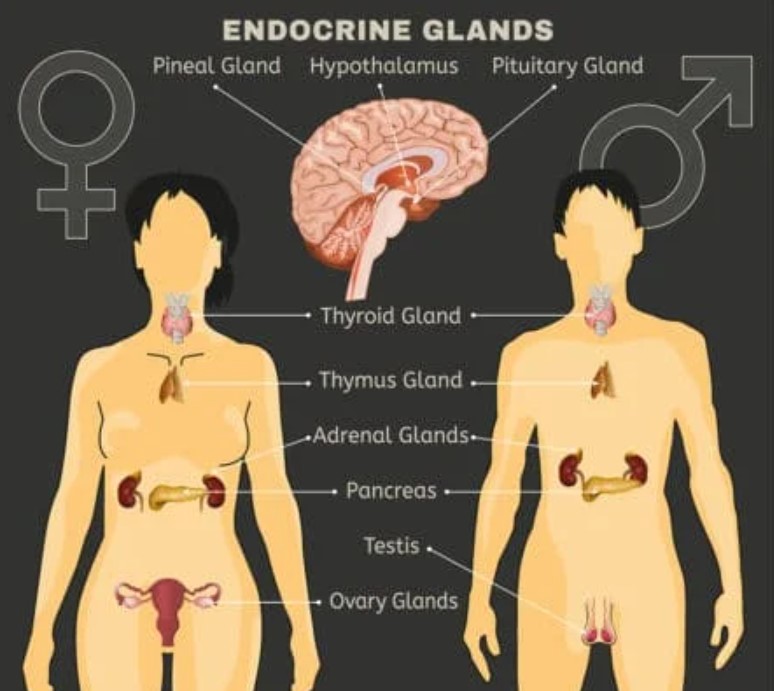
If you had to eliminate one main system from your body, which would you choose? The Digestive System? The Nervous System? Maybe the Immune System?
Needless to say, it would be a very hard decision. Every system in your body plays a mandatory regulatory role in keeping you alive and human, and all the systems are interconnected in multiple ways.
In this article, we discuss the system responsible for diabetes, moody teens, and sexual function: the endocrine system.
Just like other parts of your body, the endocrine system can be negatively affected by EMFs.
Because this system controls so many different functions in our bodies, it is important to understand how EMFs may be interfering with natural regulatory processes, and what you can do to combat the harmful effects.
What Does the Endocrine System Do?
he endocrine system is a network made up of different glands. These glands secrete hormones that help cells communicate with each other to carry out their jobs. The word endocrine comes from the Greek words “endo,” meaning within, and “crinis,” meaning to secrete.
The three main functions of the endocrine system are to:
- Make hormones that control your moods, growth and development, metabolism, organs, and reproduction
- Control the release of your hormones
- Send hormones into the bloodstream so they can travel throughout the body
To understand the endocrine system, you first must understand what glands and hormones are.
What Are Glands?
Glands are tiny organs throughout the body that produce and release substances called hormones, which perform a specific function in the body. There are two types of glands: endocrine glands and exocrine glands.
Exocrine glands—like sweat glands, salivary glands and mucous glands—are not part of the endocrine system.

The 8 major endocrine glands are:
- Hypothalamus
- Pituitary Gland
- Thyroid and Parathyroid Glands
- Thymus
- Adrenal Gland
- Pineal Gland
- Pancreas
- Reproductive organs (the ovaries or testes)
Located throughout the body, the interrelationship among these glands work to maintain our body’s internal environment.
What are Hormones?
Our body’s chemical messengers, hormones play important roles in countless bodily processes.
Hormones travel through the bloodstream, but certain hormones can only match with certain types of cells. Similar to a lock and key system, if the hormone is meant for a cell, it will fit into the cell receptor site. If it’s not a match, then there will be no hormonal effect on that cell.
While people may associate hormones with just mood swings, they are responsible for so much more.
Everything from puberty, sexual health, and sleep, to your immune system function and muscle gains are controlled by hormones. If you feel happy, your hypothalamus probably secreted some dopamine and serotonin. To maintain the levels of glucose in your blood, the pancreas creates insulin. While some parts of the endocrine system work independently, others work codependently. For example, a study published in Frontiers in Immunology determined that sex hormones and environmental factors (think EMF radiation) can affect immune response.

Hormone Imbalances Due to Endocrine Disruptors
When hormones are healthy, you’re more likely to feel vibrant and energetic. Since hormones are very powerful, they only need to be disturbed slightly to disrupt homeostasis. Many people actually suffer from hormone imbalances, even when they aren’t going through puberty, pregnancy, menopause, or other times when hormones naturally shift.
Symptoms of hormonal imbalance include:
- Unexplained weight changes
- Sleep difficulties
- Dry skin or skin problems
- Weak bones
- Changes in blood sugar and diabetes
- Irritability and anxiety
- Depression
- Headaches
- Long-term fatigue
- Bloating
- Constipation
- Reduced sex drive
- Thinning hair
- Infertility
You may experience symptoms that change the way you think, feel, and act in negative ways.
Chemicals that interrupt the natural secretion of hormones are known as endocrine disruptors (EDs). They include pesticides, flame retardants, dioxins, phytoestrogens, phthalates in plastics, perfluorinated chemicals in cookware, parabens, BHA and BPA, and more. The chief source of EDs are fossil fuels. Unfortunately, no U.S. law currently addresses EDs under an integrated framework.
Many people have switched to non-toxic and chemical-free products in their home and environment. While these EDs are legal and used vastly in consumer goods, with some even occurring naturally in meats and soy, they can change the secretions of your hormones.
This exposure is by no means deadly, and won’t give you a sickness or disease, per se, but it can create tiny, barely noticeable changes in your body so you no longer feel like yourself or perform at your best.
Infertility, sleep problems, headaches, and skin problems are universal issues that many people just accept as normal. However, it might be the case that endocrine disruptors are so common in society nowadays that everyone might be suffering from hormonal imbalances.
EMF Radiation as an Endocrine Disruptor
While EMF is not technically classified as an endocrine disruptor because it’s not a chemical, EMFs can cause similar effects as environmental toxins. Chronic exposure to EMF radiation can have a profound impact on the endocrine system.
Because the endocrine system exists throughout your body, EMFs can affect it in many ways. Let’s take a look at the different ways EMFs can impact different functions of this system.

Melatonin – Pineal Gland
Melatonin, a hormone released by the pineal gland, is perhaps the most studied in regard to technology and EMF radiation. Evidence shows that static exposure to EMF radiation can affect cyclic secretions of melatonin in several species. One effect of altered melatonin levels is disturbances to the body’s natural circadian rhythm. Melatonin also has an effect on the reproductive cycle, which will be discussed later..
Metabolism, Growth and Development – Pituitary and Adrenal Glands
The pituitary gland, along with the pineal gland, control the body’s metabolism and physiology. Some of the hormones it produces include human growth, thyroid-stimulating, follicle-stimulating, and luteinizing. When any of these hormones are affected by a disruptor, it can have a trickle-down impact on growth and development.
The adrenal glands also impact the body’s metabolism. One study found that after rats were exposed to cell phone radio frequency for six hours a day over the course of 4 to 8 weeks, the result was higher levels of ACTH and cortisol levels, two different stress hormones. The researchers found that radiation did in fact induce significant hormonal and structural changes in the adrenal gland. While there may not currently be many studies on how EMF affects hormones in humans, the research on animals and the relationship between EMFs and altered hormones is definitely cause for concern.
Because of the role the pituitary and pineal glands play in the growth and development of children, protecting children from EMF radiation is of the utmost importance. There are no long-term studies that specifically look at how EMFs affect the hormones involved in growth and development, which should only encourage us to protect children even more.
Gut Health – Pancreas
Gut health is extremely important because, now that scientists have a better understanding of its function, it’s being referred to as our body’s second brain. Gut health can influence hormonal levels, since both the adrenal gland and pancreas are located in the digestive system.
The pancreas helps regulate the metabolism of sugars, and produces insulin to do so. One study found that EMFs affected the secretion of insulin in rats. The findings showed that after being exposed to EMF frequencies for four hours a day for six weeks, insulin levels decreased. Decreased levels of insulin can lead to diabetes. Another study using rats found that daily exposure of seven hours a day, five days a week, for thirty days, impacted the levels of glucose in the blood. It’s evident that EMFs change the natural level of hormones secreted by the glands in our gut.

Sexual Function and Reproduction – Ovaries and Testes
In women, the neuroendocrine changes caused by EMFs cause hormonal changes in the reproductive system, which can lead to infertility.
One study looked at how EMFs affect the secreting activity of the pineal gland. The pineal gland produces melatonin—when its production is altered, it has a domino effect that reaches the reproductive system. Melatonin levels can disrupt the production of gonadal sex steroids. One study found that neuroendocrinological changes were believed to be the main cause of infertility with aging. Another study found that when cows were exposed to EMFs, their estrous cycle was extended, which decreases ovulation.
In 1964, the world fertility rate —meaning the total births per woman—was 5. It has been in steady decline since then, and by 2017 total births were down to half that, at 2.4. The U.S. has seen a decrease from 3.7 to 1.8 over that same time period.
Developed countries are getting hit the hardest by dropping fertility rates.
When it comes to men, there has been a sharp decline in male fertility worldwide in recent years. Some first world countries, including the US and UAE, have seen an increase in infertility by 30% since the 1980s. Sperm counts in first world countries have dropped by 50% since 1973. Coincidentally (or not), over that same time period, technology has become a staple of our everyday lives, increasing our daily exposure to EMFs. Many studies have found that EMFs have a detrimental effect on the production of sex hormones, thus impairing sexual function and reproductive activity.
The global fertility rate is declining in part because the infertility rate is increasing. Infertility means you are unable to conceive after one year (or six months if 35 years or older) of unprotected sex. It is difficult to determine the global infertility rate due to many factors. However, there are estimates that 15% of couples globally experience difficulty conceiving—which is almost 49 million couples.
There are known side effects caused by EMFs to both the physical and chemical makeup of the reproductive system, so it’s best to practice safe tech to protect your own reproductive health.

Mental Health – Pineal Gland, Hypothalamus Region
Hormones are closely related to not only a person’s physical health, but also to a person’s mental well-being.
For example, both men and women can be negatively impacted by adrenal imbalances—people with adrenal imbalances often experience anxiety, depression, and insomnia. Changes in hormones brought on by EMFs may only be furthering mental health issues.
EMFs have been found to increase the calcium ions in our cells by activating a voltage sensor in the cells’ membranes. Voltage-gated calcium channel (VGCC) activation has a direct connection to the release of neurotransmitters in the brain and in the release of hormones by neuroendocrine cells.
At first, in the pituitary and hypothalamus, EMF exposure creates higher levels of hormone secretion. But, with long term exposure, the cells become worn out, leading to lower levels of secretion, and eventually apoptosis.
The pineal gland is located in the hypothalamus region of the brain, which has a hand in controlling emotional response. When EMFs alter its hormone production, it waterfalls down onto a person’s mood.
The hypothalamic-pituitary-adrenal (HPA) axis may play a role in mood and even depression. The HPA axis is where the stress response starts in our bodies. When feeling stressed, corticotropin-releasing hormones (CRH) are released from the hypothalamus, which then travel down to the pituitary gland. Once the pituitary gland receives those hormones, it secretes ACTH into the bloodstream, alerting the adrenal gland to produce and release cortisol. Stress causes a whole chain reaction of hormone secretion, which has different physical effects on your body, such as heart pounding, muscle tension, and heavy breathing. Studies have found that depressed people typically have higher levels of CRH. From a study referenced in the previous section, we know that exposure to radiation increases stress hormones, which does not bode well for a person’s mental well-being.
Based on findings, researchers believe that ongoing exposure to stress hormones impair the growth of nerve cells in the hippocampus, the part of the brain that processes long-term memory and recollection. In studies that looked at the physical compositions of brains, it was found that the hippocampus was smaller in some depressed people’s brains.
Issues with mental health can also be triggered by improper thyroid levels. Too much thyroid hormones, known as hyperthyroidism, can cause manic symptoms. Too little thyroid hormones, hypothyroidism, can lead to depression.
Mental health in general is very important to acknowledge and understand. But, it’s necessary to address depression specifically. Depression is a very complicated matter, but it results, in part, from a chemical imbalance in the brain. Researchers are now the most informed about how the brain controls mood (looking at you, hormones). Even so, there is still much more to understand before researchers truly have a grasp on the biology of depression.
